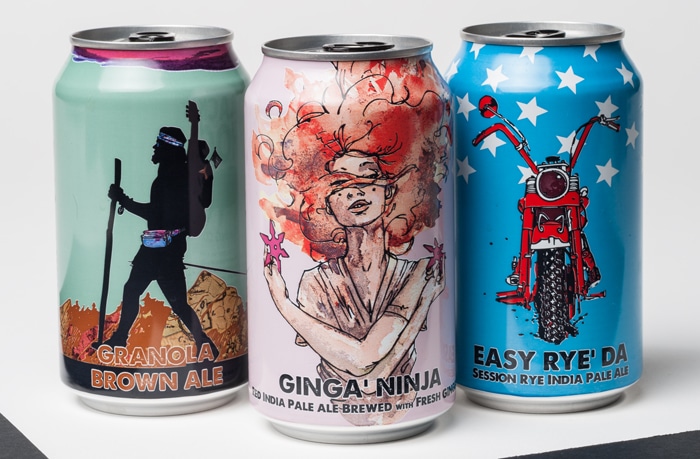By Christina Hennessy on November 22, 2015 at 1:01 AM
One day a young Connecticut brewmaster inspired by love created a red IPA, a potable of unique depth and flavor, with fresh ginger. This became Oxford’s Black Hog Brewing Co.’s Ginga Ninja, an homage to the red-haired woman who had captured his heart. So when it came to the label, do you think any image would do?
The team behind one of the state’s newest breweries didn’t think so, and instead called upon Hamden artist Maximilian Toth. The end result is a woman whose voluminous locks of red hair swirl about her head, inches above throwing stars she holds clasped in her hands. It is an image that could just as easily hang above the mantel, as slip into a beer koozie.
“We wanted Max to do some truly fine art,” says Tom Sobocinski, who opened Black Hog Brewing in 2014 with his brother Jason, a longtime friend of Toth’s, and brewer Tyler Jones. “Brewing itself is a science, but also an art. A lot of thought goes into the product.”
A potent mix of visual art, typography and storytelling, beer-label art is a siren calling from the shelf — a promise that the brew within is as interesting as the package that is covering it. As the craft-beer industry grows across the state and nation, shelf display space gets tighter, meaning the humble bottle or can must increasingly stand out.
“It is a totally new canvas for me, a very different process,” says Toth, whose work has been on display in galleries across the country, including New York City and Yale University, where he earned his master’s in fine arts about 10 years ago. “This is a new venue to play with, too, something that wouldn’t exist for me in the fine art world or, at least, I haven’t found a way to make it exist up to this point.”
Package design has long been an important element of consumer culture, and during the “Mad Men” era, top artists had their hand in design and logo creation — even some of the beer logos and label art that inspires the current generation of beer makers. But as Two Roads Brewing Co.’s Jordan Bochanis sees it, today’s craft-beer drinkers take a more holistic approach, meaning every component of creation becomes important — from the ingredients to the colors on the label.
“People who enjoy craft beers also enjoy discovering more about the beer, diving into the story, reading the labels and appreciating the art,” says Bochanis, a Bridgeport native, who handles the Stratford brewery’s design work through his agency BRZoom, which he runs with two other partners. “There are a lot of nuances in the designs that contribute to telling the story about the ingredients or how the beer was created.”
Like their counterparts in the fine arts world, afficionadoes, such as Steven Speeg, of Wallingford, collect bottles and cans, particularly those of limited runs. On a recent evening, Speeg, associate creative director at the World Wrestling Entertainment headquarters in Stamford, thumbs through the 2014 book, “Cool Beer Labels: The Best Art & Design from Breweries Around the World,” which he co-wrote with former Stamford resident Daniel Bellon. Speeg credits Magic Hat’s No. 9 as the first bottle design that caught his attention back in the 1990s — a distinct visual departure from the streams and mountain ranges that dominated the cans and bottles of mass-produced brews.
Since then, craft-beer growth has led to inventive bottles, growlers and cans from small and independent brewers. “Some are very graphic, some feature fine art illustration and some have just beautiful topography. It really runs the gamut,” says Speeg, who takes equal care in crafting labels for Spooky Brewery, the home-brewing line he does as a hobby. They are inspired by old-school horror films, such as the 1977 Italian horror film, “Suspiria.”
The book shows myriad ways brewers team up with artists to provide hints about ingredients and the type of beer brewed. Labels can hold clues as to where it is made, including glimpses of skylines or iconic images, such as the former U.S. Baird plant where Two Roads operates.
“It is an interesting medium,” Speeg says. “You only have so much space and a certain amount of that space must be for things the government makes you list. It’s why a lot of newer companies are doing cans, because you have so much more space for the art. You get a much bigger canvas.”
chennessy@hearstmediact.com; Twitter: @xtinahennessy



